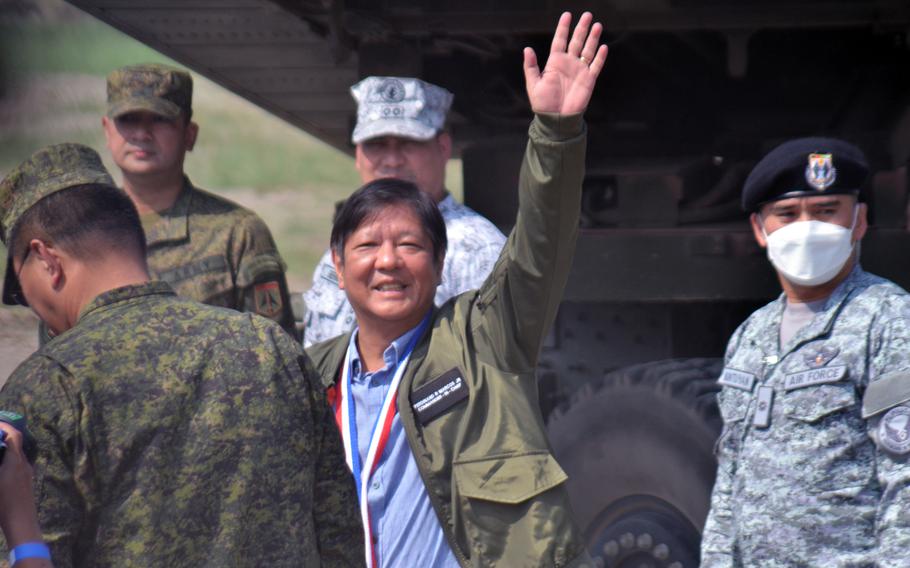
Philippines President Ferdinand Marcos Jr. waves to reporters during a Balikatan live-fire drill in San Antonio, Philippines, April 26, 2023. (Seth Robson/Stars and Stripes)
The Philippines is developing a plan to acquire submarines, the country’s president said Friday after the navy’s 125th anniversary celebration in Manila.
Multiple countries have offered to furnish the Philippine navy with submarines or to build them at Philippine shipyards, said President Ferdinand Marcos Jr., who did not identify those countries, according to his communications office.
“If they are built here and we can actually build submarines here and provide those submarines to other countries then that’s another source of jobs, and of income and increased capability for our Navy,” he said in a press release.
Last year, the Philippines’ Department of National Defense indicated that submarine procurement wasn’t a priority, according to the release.
Marcos gave no further details of the plan, including timing, budget or what mission Philippine subs would carry out. But defense experts agree that Subic Bay, a former U.S. naval facility with shipyards of its own, is an ideal site for submarines patrolling the South China Sea.
“Subic Bay is an excellent deep-water port and has played a key role in reprovisioning U.S. submarines deployed to the western Pacific as well as U.S. Navy sub tenders,” Carlyle Thayer, an emeritus professor at the University of New South Wales, said in an email Saturday.
U.S. Navy submarines operated at Subic from the 1920s until 1992, when U.S. forces departed the Philippines.
The Philippine navy also hopes to build a submarine base at Sangley Point, south of Manila, said Thayer, who is also a lecturer at the Australian Defence Force Academy.
The Philippines is engaged in a test of wills with China over control of stretches of the South China Sea and small islands relatively close to Philippine shores. A submarine base would prove useful in the Philippines’ efforts to resist Chinese encroachment into the area, Thayer said.
China’s navy maintains a constant, illegal presence inside the Philippines’ 890,000-square-mile exclusive economic zone, he said.
“The acquisition of conventional submarines capable of operating in these waters would bolster the ability of the Philippines to deter China by adding uncertainty and risk to Chinese naval deployments,” Thayer said.
The Philippine navy’s fleet currently consists of only surface vessels. By contrast, China’s submarine force will grow to 76 boats in 2030, according to estimates by the U.S. Office of Naval Intelligence quoted in a Congressional Research Service report on Oct. 7, 2021.
Philippine subs would prove worrisome to the Chinese, said Grant Newsham, a senior researcher with the Japan Forum for Strategic Studies in Tokyo.
“Ask yourself, would [China] want the Philippine Navy to operate submarines? No. That tells you it's a good thing to do,” he told Stars and Stripes in a May 23 email.
In addition, the U.S. Navy should resume its presence at Subic as a submarine “access point,” Newsham said.
“You can never have too much access,” he said.
Australian and Japanese submarines might also call there in the near future, he said.
The proximity of Subic Bay to the South China Sea is a military advantage, although submarines don’t need to be based close to their patrol area, Newsham added.
“Maybe the biggest advantage is political - demonstrating that the region's free nations are willing to fight to defend themselves and their interests,” he said.
The Philippines should acquire small diesel submarines, former Navy Capt. Jan van Tol, a senior fellow at the Center for Strategic and Budgetary Assessments, a nonprofit defense-policy think tank in Washington, D.C., said in a May 23 email.
“Having them based at Subic Bay will also require having maintenance capabilities there, some of which could conceivably be used by visiting allied vessels,” he said.